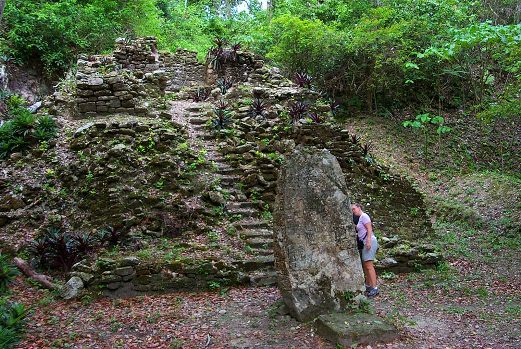

Location: Northwest Belize
La Milpa is an archaeological Mayan site located in the Three River Region in the Northwest Belize. The ruins of the site are still largely buried, but archaeologists estimate that this settlement reached an area of 18,000 square meters. La Milpa is the third largest archeological Mayan site in Belize and one of the largest sites in the region. It was originally settled around 400BC. La Milpa reached its peak during Early Classic Period. However it went into decline in the late 9th and early 10th century due to decline in the agricultural output, famine and increased warfare.
Late Preclassic/ Early Classic 400 BC- AD 500
During the Late Preclassic and Early Classic La Milpa was a small
site located on a hilltop consisting of a few pyramids, one
reservoir, and a few stelae. Excavations within Plaza A revealed a
few monuments that date to this period indicating a growing
population and therefore a need for increased space. The northern
plaza was also occupied during this period. It was the foci of
funerary monumental construction, which has led to the
interpretation the dead were buried near the main population. The
only other signs of occupation during this time can be seen in the
alteration of the surrounding landscapes, such as construction of
terraces.
These changes may have occurred to do that advent
of kingship and elite classes during the Late Preclassic. In
addition, the archaeological record suggests that the Maya divinity
controlled the population and therefore, the population was
concentrated around the center monumental constructions. While these
changes occurred fairly rapidly, the population and site stayed
small and concentrated.
During the Early Classic Period, La
Milpa saw significant growth in the production of monumental
constructions the site center. The stelae also reflected the change,
indicating a shift towards political states with institutionalized
royalty and a strong stable political system. These changes reflect
the growing political complexity as resource management became a
tool of the state due to the increasing population density. In
particular, power was negotiated by rulership through the ability to
control agriculture and the environment. Despite the growth of the
site population and density during the Early Classic Period, La
Milpa was able to sustain a large population; however, there is a
marked pause in the culturalism of the Maya within this region
during the Middle Classic Period.
Middle Classic AD 550 - 700
The Middle Classic Period is marked by a decline in culture and
populations within La Milpa and the other Three River sites. This
change can be attributed to the population shift that occurred
within the Three Rivers Basin due to the ongoing conflict between
larger cities such as Tikal, Caracol, and Calakmul. The region saw a
decline in both in populations and the controlling elite power. This
“cultural pausing” can be seen in the archaeological record due to
the lack of new monumental constructions and elite artworks. Stelae
dedications ended with the advent of the Middle Classic Period and
did not resume until the Late Classic Period during a cultural
revival.
Late/Terminal Classic 700–850
At La Milpa during
the mid-8th century, there was a steep upward climb in the
construction of monumental architecture and the dedication of
stelae. This increase in activity can be directly related to the
change in settlement patterns outside of the site core. The
Petén-centric site plan became the site pattern for the main plaza
of sites within the Three Rivers Basin. With this Petén-centric site
plan, there is a regrowth in populations and elite centers.
Along with the change in site plan patterns, there is also the
construction of two ballcourts within the site. These ballcourts
were designed with a specific layout that would orient them from
north to south and west to east. While there was a cultural
revitalization and a burst in population, the revitalization only
lasted for a short while. Following the revitalization in the Late
Classic Period, La Milpa and the surrounding sites experienced
decline and eventually collapse along with the rest of the Maya
realm. The collapse at La Milpa appears to have been rapid as
indicated by the partial completion of monumental constructions
along with other signs of sudden abandonment in the archaeological
record.
The site of La Milpa was occupied from the
Pre-classic and Early Classic into the Late and Terminal Classic,
reaching its peak during the Early Classic Period. La Milpa had
intensive agriculture as indicated by extensive terraces. The site
had a number of monumental constructions and other elite artworks,
indicating centralized power. While the site has been subjected to
numerous archaeological investigations, La Milpa remains largely
unexplored.